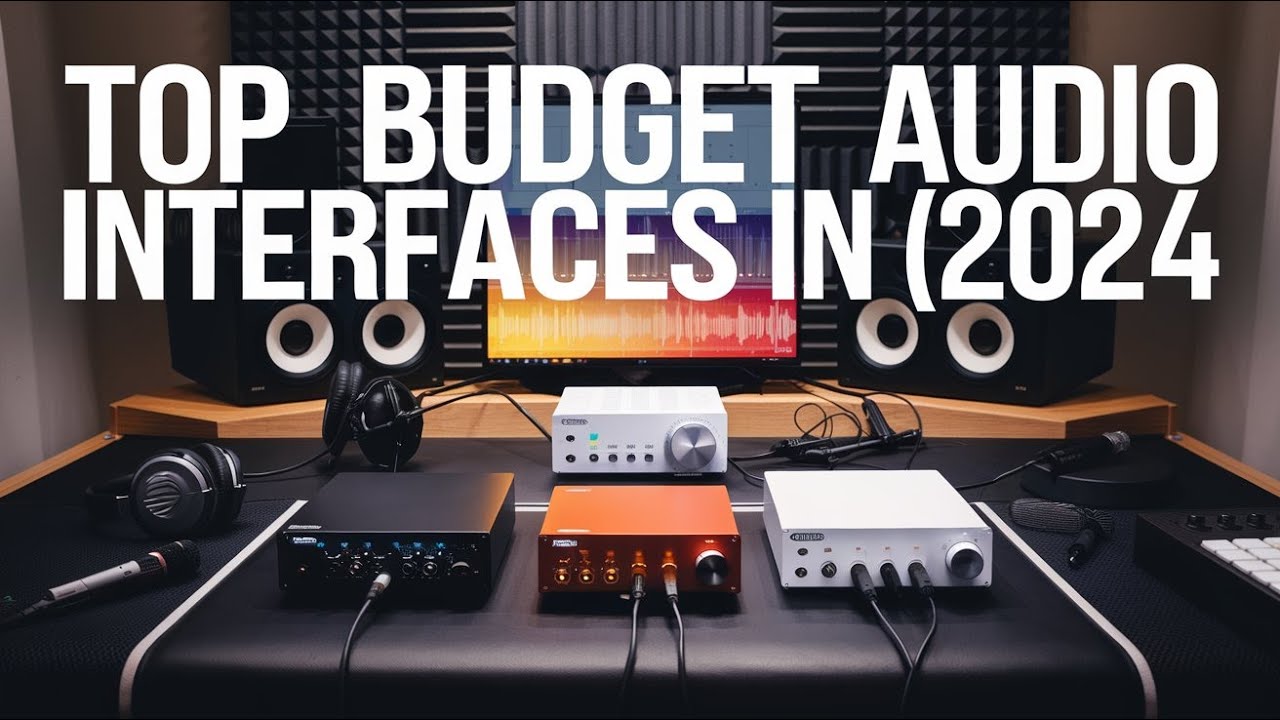If you want to record high-quality audio, one of the best audio interfaces is a studio essential. From musicians and podcasters to streamers and filmmakers, the availability of audio interfaces at reasonable prices has opened up huge opportunities for creatives, whether you’re recording a full solo album at home or wanting to collaborate with friends on a podcast. There’s a huge number of audio interfaces on the market in 2024 which can make choosing difficult, and that’s where we come in. Here at trendy reviews, we’ve tested countless models to compile this best audio interface guide. Our rigorous testing procedure encompasses everything from recording on the go with a smartphone to classic home studio recording in a permanent space.
1.Universal Audio Apollo Twin X Duo Heritage Edition
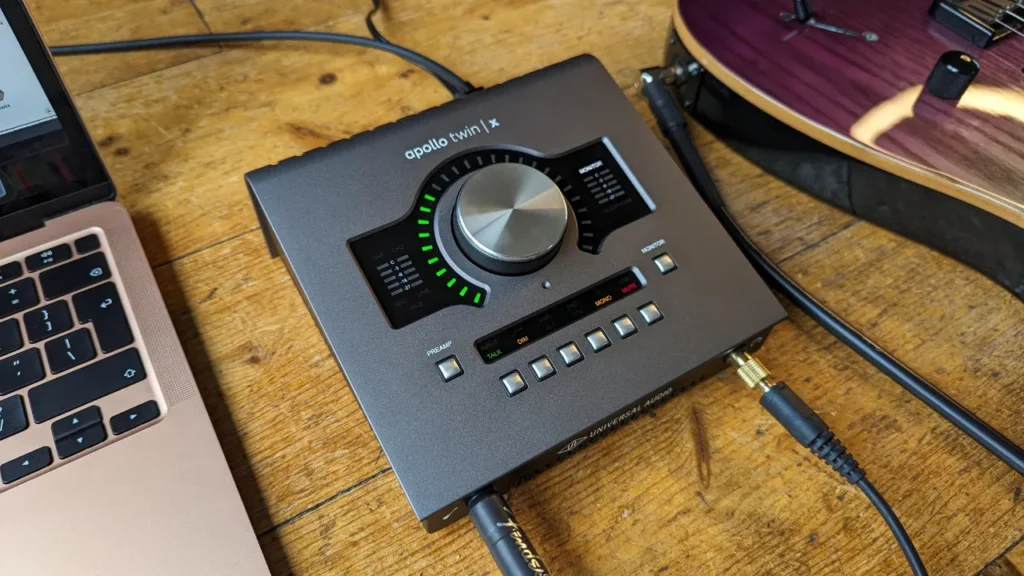
It’s interesting to note how much money guitarists like to spend on equipment that simulates technology that is fifty years old. While manufacturers employ every modern tech trick in the book to recreate the sounds and vibe of whatever vintage yesteryear they choose, we devote our playing time to emulating the tones and techniques of players who are long gone or past their prime. I can’t think of many other categories of technology where this is the case, and I’ve yet to see anyone harking for the day floppy disks return so they can store their data the way they used to.
The Universal Audio Apollo Twin X is one such piece of gear. On the one hand, it’s a thoroughbred modern audio interface with duo/quad SHARC DSP processors, advanced AD/DA conversion, and some incredible dynamic range and total harmonic distortion figures. On the other, the actual workflow is decidedly nostalgic, aiming to recreate the process of recording via an analog studio desk, using plugins modeled on vintage rackmount units from the ’60s onwards.
If you don’t think you’ll need that much power, there is a Duo version that halve the processors and is slightly less expensive than the Quad SHARC DSP processor-equipped device that I reviewed. Other than that, both machines are identical, having a headphone out and two combi inputs on the back, along with a separate guitar input on the front. Additionally, you get an optical in to increase your connectivity to up to 10 inputs, two outputs for studio monitors, and two line outs.
The Apollo Twin X unit has a substantial and comforting weight to it, and it is elegantly packaged in plush foam. It feels really sturdy because of the all-metal chassis, and the buttons and encoder knob are extremely sturdy. Given the price tag, it’s comforting to know that it is premium throughout. Strangely, there is no Thunderbolt adapter included to connect the laptop-style power cable—which locks with a twist to prevent mishaps—inside the box. This implies that you will either need to buy one separately or utilize one you already own; we’ll talk about that later.
Pros
Powerful and intuitive software
Analog approach to workflow
Cons
Annoying installation process on Mac
2.Focurite Scarlett 4I4
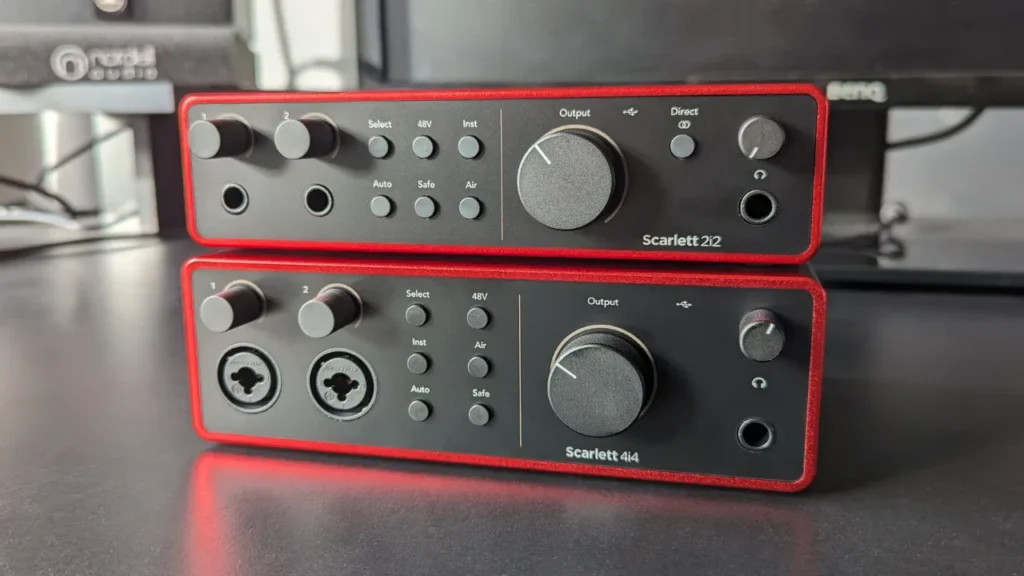
Focusrite, a British pro-audio business, has launched the Scarlett 4th Gen series, which is an evolution of their ever-present audio interfaces with improved specifications, more functionality, and a sleek new design for home recording. Does the Scarlett series continue to carry the highest torch in a competitive market against competitors like Universal Audio, SSL, PreSonus, Audient, Native Instruments, and Arturia? The home recording market has risen dramatically in the previous ten years.
Since its release in 2011, the Focusrite Scarlett’s characteristic red color has come to represent home recording. The home audio interface had not yet fully taken off at the time, and many of them suffered from poor latency, driver/compatibility problems, or insufficient processing power from computers most people could afford at the time.
For home recording musicians, the original 2i2 was a revelation when it was released because it offered an affordable, user-friendly audio interface that not only sounded amazing but also looked good—a feature that is sometimes overlooked in gear design. A whole new generation of musicians found the Scarlett intriguing because of its brushed metal vermillion shell, which stood out in an otherwise boring sea of black and grey. I purchased one right away, and to Focusrite’s credit, it continues to function.
A USB interface was once considered necessary only for ultra-geeks, but more and more guitarists are preferring to record at home and play through plugins or amp modelers. These days, a USB interface is a standard component of any modern player’s setup. Is the Focusrite Scarlett still the most popular device?
I wanted to evaluate how the auto gain and clip safe features worked before starting any real recording. I dutifully complied with the app’s request to play as though I were recording by chugging my baritone guitar as hard as I could when you click auto gain. It said the operation was finished after a short while, and the virtual knob was now properly adjusted for best results.
When I strung hard, it registered in Pro Tools at about -12dB, which is very much where I would set it if I were doing it by hand. It’s a neat feature that’s especially useful if you frequently use the same instrument because the setting is saved even after you close it.
Pros
Incredible preamp performance
Loads of useful extra functionality
Cons
We’d prefer combi inputs
3.Audient Evo 4 Audio
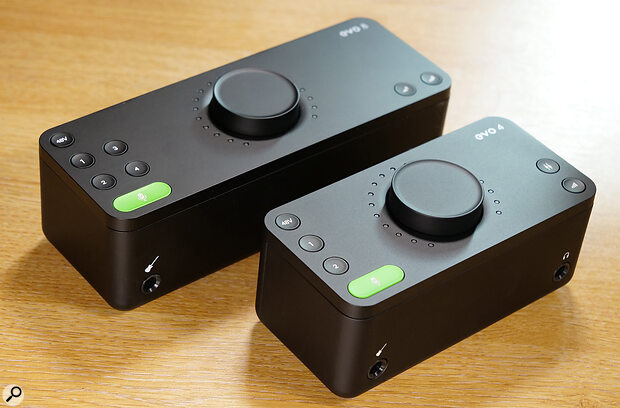
The EVO 4 and EVO 8 differ slightly. Unlike other audio interfaces, which have a 1U pro-audio feel, they have a hi-fi vibe. With only the one big knob on top and no additional gain or volume knobs sticking out from any other side, they are essentially faceless. The connectors and buttons are all flush with the surface, and the buttons have a nice black backdrop that fits with the gloomy style of the piece. The buttons illuminate a soft white. The enormous bright green button with the microphone icon, which annoysly ruins the otherwise flawless first impression, only somewhat ruins the cool impact.
You turn the central knob with your fingertips, oblivious to the interruption, and feel the soft clicks while being dazzled by the stunning illuminations of the ring of white LEDs that vanish after a pause, leaving you again in the very cool darkness trying to ignore the distracting green button.
The boxes are rather heavy, so I wasn’t worried that they would fall off the desk once they were connected. Their slightly textured matt sheen and quality feel are created by the plastic used, yet when you squeeze them, you’ll find a surprising amount of give. I discovered that if I didn’t hold the EVO 4 firmly enough, the front would unclip and need to be snapped back into place. It lacks the cool confidence of the metal-cased MOTU M2/M4 and the solidity of the plastic of the Komplete Audio 1/2/6. While the EVOs are surely not going to collapse, you don’t think they will withstand a significant downturn either.
The EVO 4 is a two‑channel in/out audio interface. The microphone inputs on the back are combi jacks and will take XLR microphone and regular jack inputs at line level. For guitar, a Hi‑Z input is located on the front, and routes to channel 1. This is run by JFET transistor technology for some added tone. The EVO 8 is the same, just with an extra pair of combi inputs, which it stretches to accommodate an additional pair of line‑level outputs plus a second headphone output. The EVO 8 comes with a USB‑C cable which allows it to pull in 48V phantom power over USB to run all four microphone inputs, although if you use a USB‑C to USB‑A cable or adapter it will only be able to power two inputs over bus powering. The EVO 4 comes with the USB‑C to USB‑A cable as it only has the two microphone inputs to power.
Pros
Minimalist design
Great latency performance
Cons
No at‑a‑glance overview on the hardware
4.Audient ID4 MKI Audio
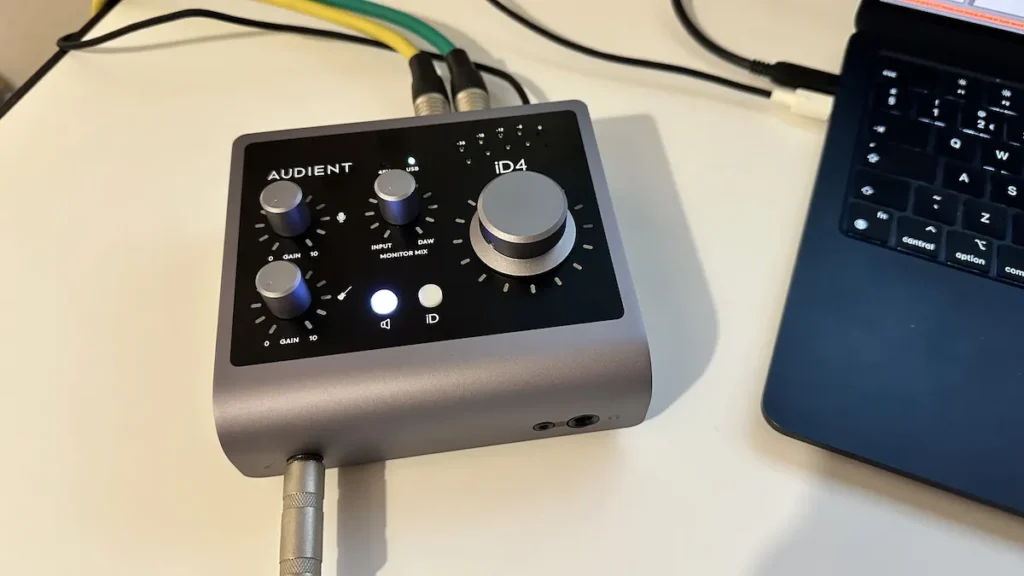
There are high expectations for the second version of Audient’s iD line of low-cost interfaces. The initial iterations were highly esteemed, providing a blend of deliberate craftsmanship and some delightful details that raised them above other competitors in the congested entry-level interface category. Fortunately, the Audient iD4 MKII’s capabilities are immediately obvious from the box.
This is a rather basic two-in/two-out USB audio interface that has a single ¼” jack input on the front and an XLR/jack combi input on the back. Furthermore, there is a stylish dual-output headphone area on the front with a ¼” and a 3.5mm output that may be used simultaneously or as an auxiliary output.to send audio out to a guitar pedal. The back of the unit then houses the standard stereo jack outputs and connection for the interface’s USB-C cable. All of the main controls – gain for both channels, a monitor mix knob and a large, chunky volume encoder – sit atop the surface of the unit, keeping them within easy reach for those crucial tweaks.
The iD4’s iD button unlocks some useful features too. The ‘Scroll Control’ feature turns the master volume knob into a scroller for whatever you’ve highlighted using your mouse. I found this was especially helpful when I was recording automation lines into Live, raising and lowering the FX mix of a heavy-sounding reverb to accentuate certain parts of the recording. This kind of tactile control is not something you’d necessarily expect from an audio interface, nor something you’ll use all the time, but a nice touch all the same.
The dual monitor mix feature was also helpful. By holding both the mute and iD buttons, the main encoder then created a stereo sub-mix of the mic and line inputs, allowing me to hear the mic in one ear and the guitar in the other. Again, a small feature but one that shows the people who have made this interface understand musicians and the situations they could find themselves in.one ear and the guitar in the other. Again, a small feature but one that shows the people who have made this interface understand musicians and the situations they could find themselves in.
Pros
Simple to use
Great for guitars
Cons
Not much to criticise at this price
5.Focusrite Scarlett Solo

If you’ve recorded in the last few years, either at home or in a high-end professional studio, you’ve undoubtedly used Focusrite equipment to process and enhance your signal. From the first consoles that the renowned Rupert Neve created for producer George Martin to the widely available models that are within reach of the average person, the company’s interfaces and mic pres are legendary. And how accessible they’ve gotten, too. Behold the Focusrite Scarlett Solo 3rd Gen, the latest generation of this well-loved USB audio interface family.
This new device is essentially an effect pedal in size and cost, but it packs years of recording expertise and tone into a little box.
Scarlett Solo, despite her little stature, exudes professionalism. For the most part, Focusrite owns the red anodized look, and it simply reeks of quality. Once you hook it up to your computer via USB and run balanced cables (an upgrade from the 2nd Gen’s RCA jacks) to your monitors, everything you’ll ever need is right there on the front panel.
The Scarlett Solo comes bundled with XLN Audio Addictive Keys, Ableton Live Lite, Focusrite Red 2 & 3 Plugin Suite, Focusrite Drum Tracks, Pro Tools, First Focusrite Creative Pack, Softube Time & Tone Bundle and Splice Subscription. Whew! In short, if you have a guitar, a cable and a mic, you can create a complete arrangement as soon as you’re finished the installation.
I put the 1/4-inch input’s gain control to the test by tracking a Carvin Jason Becker guitar with high-output active pickups as well as an old Applause acoustic-electric with a rather anemic piezo, and I had no problems matching levels.
Tracking in Pro Tools as well as Cakewalk by Bandlab was a breeze, as it should be in this day and age. The bundled Focusrite EQ software is powerful and easy to use, and the direct monitor function made it simple to record with plug-in effects and listen in real time. Bravo!
Pros
Beautiful sound quality
Elegant cosmetics
Cons
Some studios might require more I/Os
What is an audio interface?
Consider an audio interface as a go-between for your computer and your music. The analogue to digital (ADC) converter in your interface processes your musical inputs and changes them into 1s and 0s that your computer can comprehend.
Your audio interface will then transform these 1s and 0s back into a waveform once they have been altered in your computer, normally in a DAW, allowing you to hear the signals through studio monitors or headphones. A digital to audio converter is used for this process (DAC).
Who are audio interfaces for?
For those who wish to record audio, the finest interfaces are those for recording. You can listen to podcasts, electric guitar music, electronic dance music, or even simply the audio from your most recent streaming episode. We have considered a wide range of use cases when selecting the products for this guide, and there are many reasons why someone might require an audio interface.
What are the different types of audio interface?
The work of most interfaces is essentially the same. The method they link is the only significant differentiator you’ll need to take into account. Some link to your laptop or computer via PCIe, Firewire, Thunderbolt, or USB. Most interfaces include USB connectivity, but it’s a good idea to double check that your computer is using the correct port. In this article, we examine the distinctions between Thunderbolt and USB audio interfaces.

